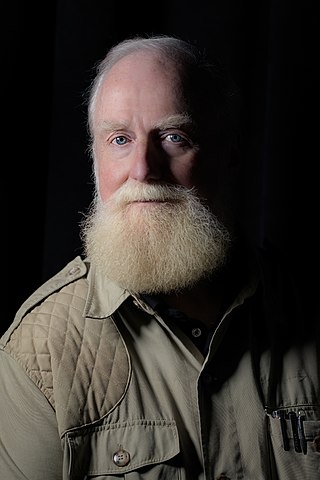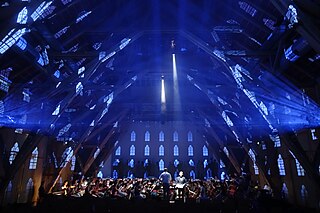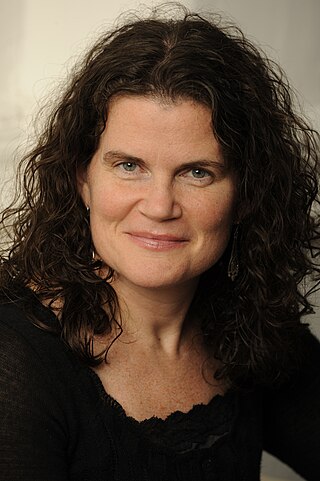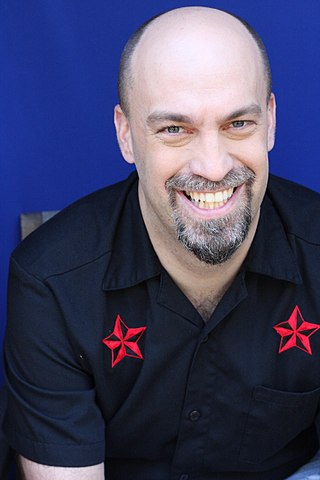
Stagecraft is a technical aspect of theatrical, film, and video production. It includes constructing and rigging scenery; hanging and focusing of lighting; design and procurement of costumes; make-up; stage management; audio engineering; and procurement of props. Stagecraft is distinct from the wider umbrella term of scenography. Considered a technical rather than an artistic field, it is primarily the practical implementation of a scenic designer's artistic vision.

William Peter Charles Williams is an English show director, stage and lighting designer and video director for concerts, theatre and multimedia projects. He is best known for his work with the rock band U2, and is recognised as one of the leading artists in this field. William Gibson, writing in Wired magazine, said "Willie Williams combines a passionate delight in technology with an infectious low-tech joy. His innovations have become industry standards."

A stagehand is a person who works backstage or behind the scenes in theatres, film, television, or location performance. Their work include setting up the scenery, lights, sound, props, rigging, and special effects for a production.

Bran Ferren is an American technologist, artist, architectural designer, vehicle designer, engineer, lighting and sound designer, visual effects artist, scientist, lecturer, photographer, entrepreneur, and inventor. Ferren is the former President of Research and Development of Walt Disney Imagineering as well as founder of Associates & Ferren, a multidisciplinary engineering and design firm acquired in 1993 by Disney. He is Chief Creative Officer of Applied Minds, which he co-founded in 2000 with Danny Hillis. Apple's "pinch-to-zoom" patent, which features prominently in its legal battle with Samsung, was invalidated by the US Patent and Trademark Office in 2013 based on a 2005 patent by Ferren and Hillis for multi-touch gestures.
Christopher Akerlind is an American lighting designer for theatre, opera, and dance. He won the Tony Award for Best Lighting Design for Indecent. He also won the Tony Award for Best Lighting Design and the Drama Desk Award for Outstanding Lighting Design for Light in the Piazza and an Obie Award for sustained excellence for his work Off-Broadway.
Zachary Borovay is an American media designer, educator, creative director and team leader specializing in Broadway, Off Broadway, Concerts, Opera, Theme Parks, Corporate Events and Museum Installations. His work has been seen all over the world.
Richard Pilbrow was a British stage lighting designer, author, theatre design consultant, and theatrical producer, film producer and television producer. He was the first British lighting designer to light a Broadway musical on the Broadway stage with the musical Zorba.
Rick Fisher is an American lighting designer, known for his work with Stephen Daldry on Billy Elliot the Musical and An Inspector Calls. He is from Philadelphia, Pennsylvania and attended Dickinson College, but has been based in the UK for the last 30 years.

Video design or projection design is a creative field of stagecraft. It is concerned with the creation and integration of film, motion graphics and live camera feed into the fields of theatre, opera, dance, fashion shows, concerts and other live events. Video design has only recently gained recognition as a separate creative field. For instance, United Scenic Artists' Local 829, the union representing designers and scenic artists in the US entertainment industry, only added the Global Projection Designer membership category in 2007. Prior to this, the responsibilities of video design would often be taken on by a scenic designer or lighting designer. A person who practices the art of video design is often known as a Video Designer. However, naming conventions vary worldwide, so practitioners may also be credited as Projection Designer, "Media Designer", Cinematographer or Video Director. As a relatively new field of stagecraft, practitioners create their own definitions, rules and techniques.
Clifton Taylor is a theatrical Designer who is based in New York.

Gareth Owen is a twelve-time Tony & Olivier award-winning / nominated Broadway and West End sound designer, described as one of "the only behind-the-scenes creatives whose star wattage spells success on [theatrical] productions".
Lee Rose is an American lighting designer that works in the mediums of film, television, stage, and concerts.
Tim Routledge is a British lighting designer, creative designer, and lighting director who works in television, music concerts, outdoor events, award shows, and variety shows.
Jonathan Richard Driscoll is an English Olivier Award-winning and Tony-nominated theatre projection designer and lighting designer working in the West End and on Broadway. He is a Technical Associate of the National Theatre in London.

Elaine J. McCarthy is an American projection and video designer for theater and opera.
Wendall Keehn Harrington is an American theatrical projection designer and head of projection design at Yale School of Drama, sometimes referred to as 'The Queen of Projections’. She has been considered the nation's leading projection designer for more than three decades.

Lindsay Draper Jones is an American composer and sound designer for theater, television and film. He has also taught and lectured at numerous universities and schools across the country.

Daniel Flannery is an American artist, creative producer, theatre director, scenographer, film/television director, director of photography and lighting designer.
Neil Austin is an English lighting designer. He has won two Olivier Awards and three Tony Awards and is the lighting designer for Harry Potter and the Cursed Child, for which he has won an Olivier, Tony, Drama Desk, Helpmann, Outer Critics Circle and WhatsOnStage Award.

Abe John Jacob is an American sound designer and audio engineer. Called the "Godfather of Sound", Jacob greatly influenced the design of sound reinforcement in modern musical theatre, and was one of the first persons credited in the role of sound designer on Broadway, with a sound designer credit in Playbill in 1971.










